
Voguing: The Empowering Dance of LGBTQ+ Pride
Beyoncé, Madonna and other divas have found artistic inspiration in it
«As they couldn’t be themselves because they were beaten up on the streets, they invented a parallel universe where they could be themselves. Be that diva they couldn’t be during the week.» That’s how Jordi Chicletol, organizer of World Pride is Burning, explained to LOS40 the origins of Voguing the first time we talked about this empowering dance. Now, with the arrival of LGBTQ+ Pride 2023, we want to once again remember the basis of this liberating cultural movement in a time of darkness and persecution for the community.
But first, what exactly is voguing? The term itself comes from the famous magazine ‘Vogue,’ as it is an extravagant and performative dance that imitates the iconic poses of the it girls who graced the covers in the 80s. It’s a dance born in the LGBTQ+ circles of the Latino and African-American community in 60s Harlem, driven by an unwavering need for artistic and identity expression. In fact, Jordi summed it up perfectly back then: «I would summarize voguing as ‘be whoever you want to be.'»
This legendary dance, born in the purest underground scene where the community built spaces of resistance and mutual support (in this case, we are referring to the well-known ballrooms), gained the highest popularity when Madonna released ‘Vogue’ in 1990. Her iconic «Strike a pose!» captures the essence of voguing, further represented in the documentary ‘Paris Is Burning’ from the same year, which portrays the New York ballroom scene of the 80s, or more recently in the acclaimed ‘Pose’ (2018). These productions not only showcase its artistic aspect but also provide reflection on the gender, race, and sexual orientation of its protagonists.
Besides the queen of pop, other great divas have been inspired by voguing and its meaning to create their own art. We recently saw a clear example of this in Beyoncé’s latest album, ‘Renaissance,’ where the iconic singer pays homage to ball culture and queer African-American music. In fact, her world tour also incorporated a Voguing Ballroom interlude, with a disco and futuristic aesthetic where sparkle and metallic fabrics prevail. Precisely in the live performances the artist counts with great artists of the vogue scene, such as the iconic Honey Balenciaga, who uploads videos to her social networks where we can clearly see how this dance is done.
We also saw it clearly in Lady Gaga’s historic ‘Born This Way’ (2011), in the title track and others like ‘Fashion of His Love,’ with a clear reference to the aesthetic elements of voguing. In reality, there is a long list of artists who have followed the same path, such as Rihanna with her iconic song ‘Rude Boy’ or ‘Pose,’ Azealia Banks in ‘Miss Amor,’ part of ‘Broke With Expensive Taste’ (2014), or FKA Twigs in ‘Glass & Patron.’
And you? Were you familiar with voguing and its significant meaning?